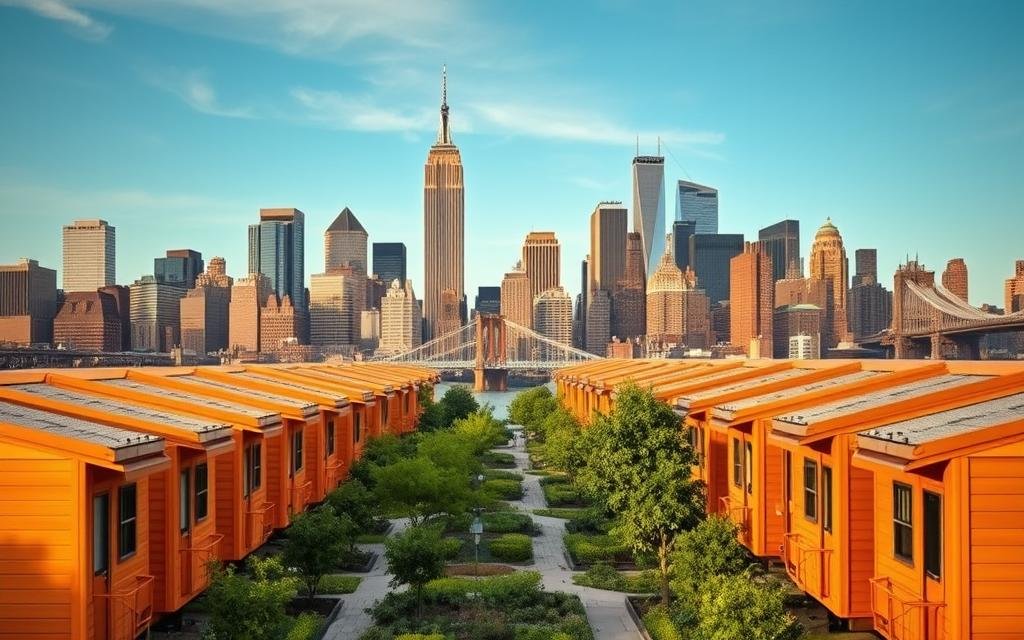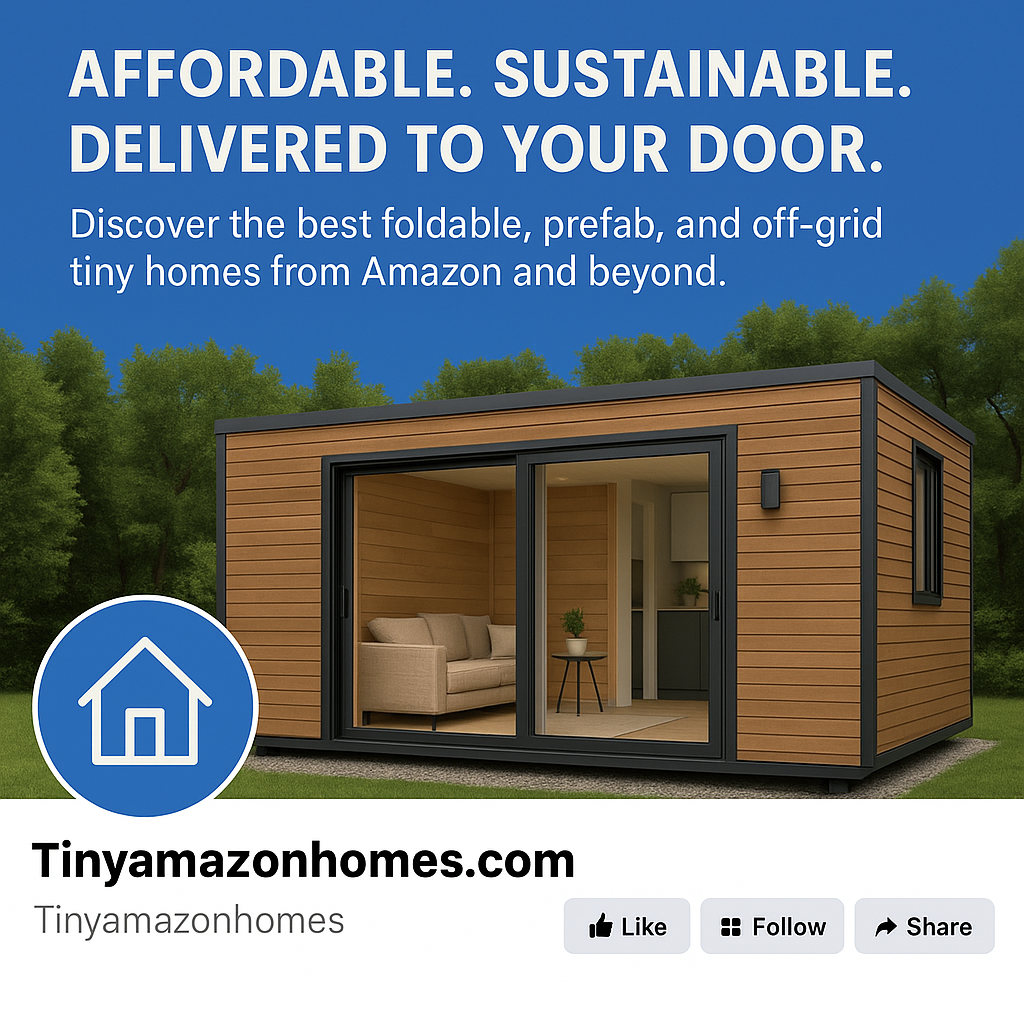The housing crisis in New York City is severe. The housing cost ratio is 1.766, showing a big difference in costs for homeowners and renters. But, a breakthrough in affordable housing is coming.
The “Tiny Towers” project is a new solution. It offers over 150 stackable 280-sq-ft units in the Bronx. The rent is set at 30% of the area median income, about $800 a month. Its design includes fold-away furniture and shared rooftop farms. This makes it a great choice for low-income families.
Key Takeaways
- Innovative “Tiny Towers” project offers affordable housing in NYC.
- Over 150 stackable units available in the Bronx.
- Rent is fixed at 30% of the area median income.
- Unique design features fold-away furniture and shared rooftop farms.
- Attractive option for low-income households.
The Housing Crisis in New York City: Setting the Stage
New York City’s housing market is in crisis. Costs are up, and affordable homes are scarce. Renting a place costs $1,748 a month, and owning a home costs $3,087. This makes it hard for low-income families to find a place to live.
Housing costs are squeezing household budgets. Many spend over 30% of their income on housing. This shortage of affordable homes is making the crisis worse.
Current Challenges in NYC’s Housing Market
The housing market in NYC faces many challenges. High demand and limited supply push prices up. This makes it tough for low-income families to find affordable homes. Also, many buildings need repairs or are too old.
| Housing Type | Median Monthly Cost | Percentage of Income |
|---|---|---|
| Renting | $1,748 | 43.7% |
| Homeownership | $3,087 | 51.5% |
The Growing Need for Innovative Solutions
NYC needs new, creative solutions to its housing crisis. There’s a big need for new york city housing programs that offer low-income housing options. These programs can help ease the financial burden on families.
Community-led projects and affordable housing programs are key. They can provide more affordable homes for low-income families. Ideas include community land trusts and cooperative housing models.
By exploring these ideas, NYC can tackle the housing crisis. It can offer more affordable homes to its residents.
NYC’s Affordable Housing Breakthrough: Introducing “Tiny Towers”
NYC is launching ‘Tiny Towers’, a bold move to solve the housing shortage. This project aims to change how we think about affordable living in New York City.
The Concept Behind Tiny Towers
‘Tiny Towers’ will have 8-story buildings with over 150 stackable units, each 280 square feet. The design is all about using space wisely, making it a great choice for affordable housing in NYC.
The stackable units are designed to be compact yet functional, with rent set at 30% of the area median income, about $800 per month. This pricing is a big step towards making housing more affordable for low-income families.
New York City Council’s Approval Process
The ‘Tiny Towers’ project went through a tough approval process by the New York City Council. The council looked at how the project would affect the community, its environmental impact, and if it followed NYC’s housing rules.
The approval was granted because the project could help solve the housing crisis and offer a new way to make housing affordable. The council’s yes vote shows their dedication to finding new ways to tackle NYC’s housing problems.
Why the Bronx Location Matters
The Bronx was picked for ‘Tiny Towers’ because of its close location to community resources and transportation. This location improves residents’ lives by giving them easy access to important services and the rest of the city.
- The area’s existing infrastructure supports the integration of new housing developments.
- Residents will benefit from being close to community facilities, parks, and public transport.
‘Tiny Towers’ is a big step for NYC in tackling its housing affordability crisis. By introducing new housing ideas, the city is getting closer to its goal of making housing affordable for everyone.
Inside the Tiny Towers: Design and Features
The Tiny Towers is a new take on affordable housing, showing us what the future of city living could be. It’s not just about a place to live; it’s about building a community that’s green, smart, and welcoming.
Stackable 280-Square-Foot Units Explained
The Tiny Towers have stackable units, each 280 square feet. They’re small but packed with features, making the most of every inch. This design lets developers use land and resources wisely.
These units are all about being smart. They have efficiency in mind with fold-away furniture and clever storage. This makes them not only cozy but also affordable.
Innovative Space-Saving Solutions and Fold-Away Furniture
The Tiny Towers are known for their clever use of space. They have furniture that folds away, letting you change your space as you need. For instance, a dining table can fold up to make room for more space, or a bed can hide to turn the area into a living room.
- Fold-away beds and tables
- Innovative storage solutions
- Efficient use of vertical space
Balancing Privacy and Community Living
Even though the Tiny Towers are designed to save money and space, they still focus on privacy and community. Each unit has its own private areas. But there are also shared spots like rooftop farms and community rooms to bring people together.
| Feature | Description | Benefit |
|---|---|---|
| Stackable Units | 280-square-foot units designed for efficiency | Maximizes land use and reduces costs |
| Fold-Away Furniture | Innovative furniture solutions for space-saving | Enhances livability and flexibility |
| Shared Community Spaces | Rooftop farms and community areas | Fosters community and social interaction |
The Tiny Towers are a big step in the right direction for affordable housing. They show how to make living spaces efficient, green, and community-focused. As it grows, it could inspire similar projects in New York City and elsewhere.
Affordability Metrics: Breaking Down the Costs
“Tiny Towers” is changing the game for affordable housing in New York City. It offers a new pricing strategy that makes homes more accessible. This project helps people understand the costs and how they compare to other housing options in NYC.

Pricing Model Based on Area Median Income
The “Tiny Towers” project sets rent at 30% of the area median income (AMI). This is about $800 per month. This way, housing stays affordable for those with lower incomes.
Key benefits of the 30% AMI pricing model include:
- Reduced financial burden on low-income households
- Increased affordability for those struggling with high rent costs
- A more equitable distribution of housing costs relative to income
Eligibility and Application Process
To qualify for “Tiny Towers,” you must meet certain income requirements. This ensures the housing goes to those who need it most. The application process is easy and clear, with all the details provided.
The eligibility criteria include:
- Income limits: Households must have incomes at or below 30% of the AMI.
- Residency requirements: Applicants must be NYC residents or have a demonstrated need to reside in NYC.
- Application submission: Prospective residents must submit a complete application, including required documentation.
Comparison with Traditional NYC Housing
“Tiny Towers” is a more affordable choice compared to traditional NYC housing. Its unique pricing and space-saving design make it appealing for those seeking affordable housing in NYC.
| Housing Option | Average Rent | Affordability Index |
|---|---|---|
| Tiny Towers | $800 | High |
| Traditional NYC Housing | $1,500 | Low |
In conclusion, “Tiny Towers” is poised to greatly impact NYC’s affordable housing scene. Its innovative pricing and simple application process make it a great choice for low-income families.
Community and Sustainability Features
“Tiny Towers” is changing the game for affordable housing in New York City. It tackles the need for affordable homes and promotes sustainable living.
Shared Rooftop Farms and Community Spaces
“Tiny Towers” boasts shared rooftop farms and community spaces. These areas help residents feel connected, offering a green escape in the city. Residents can even grow their own food here.
The community spaces have fold-away furniture. They’re perfect for events, study groups, or just relaxing. These spaces make living here better for everyone.
Environmental Impact and Sustainability Initiatives
“Tiny Towers” aims to reduce its environmental impact. It uses energy-efficient appliances and green roofs. This cuts down on energy use and helps the planet.
The table below shows some key sustainability features of “Tiny Towers”:
| Sustainability Feature | Description | Benefit |
|---|---|---|
| Energy-Efficient Appliances | Appliances that consume less energy | Reduced energy bills for residents |
| Green Roofs | Rooftops covered with vegetation | Improved insulation, reduced urban heat island effect |
| Shared Rooftop Farms | Productive green spaces on rooftops | Fresh produce for residents, community building |
By focusing on sustainability, “Tiny Towers” makes a positive impact. It creates a healthier living space for its residents. This project is a big step towards affordable, sustainable housing in NYC.
Conclusion: The Future of Affordable Housing in NYC
The “Tiny Towers” project is a big step forward for affordable housing in NYC. It offers a new way to tackle the city’s housing problems. This project could be a model for future affordable housing in the city.
Affordable housing in NYC has been a big challenge for a long time. But “Tiny Towers” brings new hope. It provides small, stackable units and community spaces. This shows that affordable housing can also mean living in a community.
The success of “Tiny Towers” could lead to more affordable housing projects in NYC. These projects will use new designs and green practices. As NYC grows, projects like this are key to solving the housing crisis and making housing affordable for everyone.
